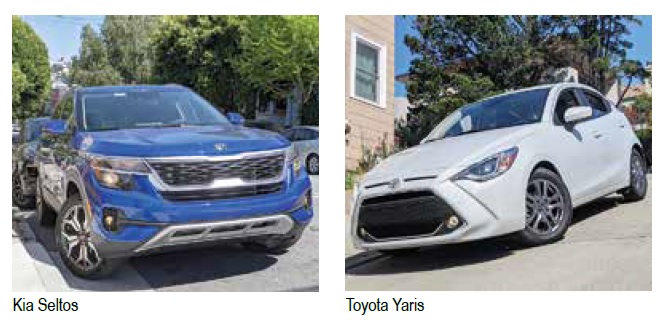
By Philip Ruth–
“No, I’ve got you beat,” said a client, as we compared our losses of income during our current pandemic. Mine was the sudden torching of the classic-car market, as few are looking to buy little beyond toilet paper and pantry basics, much less an expensive toy they aren’t currently allowed to drive very far.
“Same here, except mine’s jewelry,” he replied. But he did have me beat, as his main income came from brokering international travel, specializing in cruises. Ouch, right?
Thankfully journalism is an essential service, and the two five-door pressers we’ll check out this week—the Kia Seltos and Toyota Yaris—revealed a lot about themselves even within the current strict boundaries of travel.
The Seltos and Yaris are sized differently, and the Yaris hatchback I examined was a parking star, with an overall length less than 162 inches. If you chose the trunked Yaris sedan, its length compared to the Seltos would be a draw at 172 inches. The Seltos’ crossover nature takes it from there, with four more inches of width and five more in height.
As you’d expect, the Yaris is economy-car affordable, with base prices (including delivery) in the $16,000–$19,000 range, while the Seltos starts at just over $23,000 and heads upward as luxury items and a turbocharger are added. I drove the top Yaris XLE hatchback, priced just less than $20,000, and the Seltos S Turbo’s price added about $7,000 to that.

Driving both of them represented bright spots in a dark week with rivers of bad news, and not just because they got me out of the house. The Seltos and Yaris I sampled were lively and engaging.
The Yaris widely sold outside the U.S. is a Toyota design, and they’re welcome to it, because our Yaris is a rebadged Mazda. That means it has Mazda’s rare combination of substance and light weight, and it feels ready to run whenever you are.
Toyota sells the Yaris hatchback with a six-speed automatic; the manual option is sedan-only. The automatic maximizes the 1.5-liter four-cylinder’s 106 horsepower, but there are no silver bullets here. Sport mode sharpens takeoffs but leads to abrupt shifts, while Normal mode is slower to start but operates more smoothly as speeds climb.
The Seltos felt strong, thanks to the 175 horses produced by the turbocharged 1.6-liter engine; and its dual-clutch, seven-speed transmission was responsive. Handling was precise enough to make the Seltos feel sporty.
Both were accommodating inside, though the driver’s seat in the Seltos was unworkable for me, as it pushed forward my shoulders and left my lower back hunting around for firmness. A jump from the tested S trim level to the SX, with its 10-way power seat with lumbar support, would likely solve that.
To my eye, the Seltos and Yaris both have attractive styling, with tight contours and an athletic presence. And in our time of uncertainty, both were reminders of how satisfying a well-designed car can be.
Philip Ruth is a Castro-based automotive photojournalist and consultant with an automotive staging service.
Published on May 7, 2020
Recent Comments